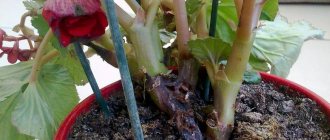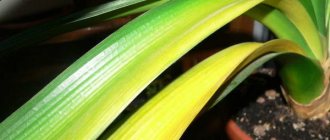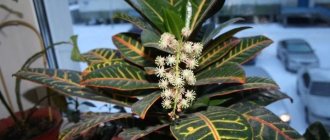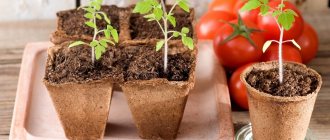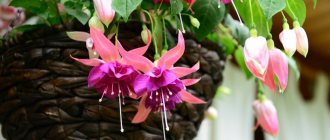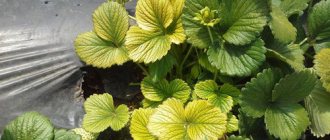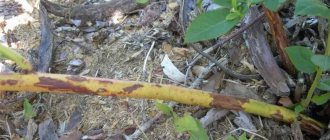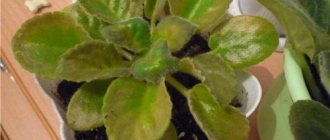February 15, 2021 ditim Home page » Reading Views:
There are much fewer diseases in plants than in people. But the seedlings won’t tell us what’s bothering them, and this is the main difficulty - identifying the problem and applying the right treatment. And we, gardeners, have to act as doctors... If you look at the directory of tomato diseases, you can count more than fifty diseases, and almost all of them are accompanied by yellowing of the leaves. But there are still pests...
Spring has come - the leaves have turned yellow...
We list the main reasons for changes in leaf color in seedlings:
- Fasting, lack of nutrients (nitrogen, potassium, iron, magnesium, manganese),
- Blackleg disease (“root collar rot”),
- Bacterial wilt, Fusarium wilt, Verticillium wilt,
- Spider mites or thrips have infested the seedlings,
- Errors in care, stress.
The most common and common reason why seedlings of peppers, tomatoes, cucumbers, eggplants, and petunias turn yellow is a lack of macro- and microelements in the soil.
Causes and methods of treating yellow leaves on tomato seedlings
Determine the cause of yellowing leaves and learn how to correct it so that your tomato seedlings grow healthy and strong.
| Cause | Solution |
| Excess or lack of water | Determine how much water your seedlings need (see below) |
| Compacted soil | Loosen the soil around plants more often |
| Virus, fungus or bacteria | Read rblogs.ru further for a complete list of solutions to the problem |
| Not enough nutrients | This could be a deficiency of nitrogen, minerals, etc. See below for signs and solutions |
| Lack of sun | Rearrange the seedlings so they receive more sunlight. If this is not possible, arrange additional lighting |
Lack of nutrients in the soil
is reflected in the color of the leaves of young plants - they change their color. When there is little nitrogen, the leaves turn pale, turn yellow, become smaller, and the plants themselves look lethargic and lifeless. With a deficiency of potassium and iron, the leaves not only turn yellow, but also curl. First of all, the lower leaves of the seedlings turn yellow:
What to do?
There is no need to rack your brains over which microelement plants are deficient in. Fertilizing with a solution of complex mineral fertilizers will allow you to improve the situation and balance the composition of the soil:
- Solution of the drug "Fertika Lux". Dissolve half a tablespoon (10 g) in 10 liters of water and water the seedlings at the root. Feeding can be done once a week.
- Emerald - this fertilizer is also used to feed yellowed garden and indoor plants, including seedlings. Use according to instructions.
- Ferovit is a universal stimulator of photosynthesis and respiration.
Instructions for use:
(not an advertisement, I just came across such a good description of this drug in country literature)
The arsenal of plant care products is now huge, and other complex mineral fertilizers for seedlings can be purchased at the garden store.
Rules for feeding seedlings
Plant nutrition is important in the process of growing seedlings. This must be done at least twice:
- The seedlings are fed for the first time after a pair of true leaves appear. As a fertilizer, use a solution of copper sulfate in a ratio of 1 tsp. for 1 l. water. By the way, this is a good prevention of late blight;
- The second feeding is carried out a week after the first. This time, urea is used as fertilizer, dissolving 1 tbsp. l. product in 10 l. water. This will help saturate the soil with nitrogen, which is necessary for normal crop growth.
If such a need arises, you can once again feed the seedlings with complex fertilizers.
Important point! Fertilizing should be carried out only after preliminary watering. This will help protect the plant's roots from burns.
We must not forget that everything is good in moderation, so you should not be too zealous when fertilizing the soil. In some cases, the cause of yellow leaves is an excess of minerals. If this does happen, it is recommended to water the seedlings with warm water and refrain from feeding for a while.
The black leg kills on the spot!
The defeat of the black leg is expressed not only in yellowing of the leaves. The main distinguishing feature is the blackening of the stem, and then the complete death of the plant. This fungal disease is also called root collar rot.
Main signs of the disease:
- Plants turn yellow and wither,
- Some parts of the root and stem become black, dry out,
- The leaves turn yellow, curl, dry out,
- Yellowing is also observed on the stems of the plant.
- A stem weakened by disease easily breaks under its own weight.
- By dipping the stem in water, you can find mucus on its lower part.
If all these signs are present, there is no doubt - this is root collar rot!
An insidious fungus settles in the root collar of young or adult plants, seals the vessels in the stems, disrupting metabolic processes. The seedlings stop feeding, and gradually the leaves of the seedlings turn yellow . Ultimately, root collar rot leads to the death of the young plant if no healing measures are taken. What to do? The plant can be saved!
By the way! Seedlings may also turn yellow due to fusarium. But in this case, mostly the lower leaves turn yellow . First the shoots wither, and then the whole plant completely. The fungus also affects blood vessels. But unlike the black leg, in the area of the root collar with fusarium, a pink coating is visible, and on the cut of the stem there is a darkening of the vascular ring. The disease is called "Fusarium wilt".
The following factors favor the development of fungi:
- Overmoistening of the soil,
- Low temperatures,
- Dense sowing,
- Low illumination,
- Bad soil
- Increased soil acidity (PH above 6.5).
What to do?
The drug Glyokladin is especially effective in the fight against blackleg It is used both for prevention (when preparing the soil) and for treatment in the first stages of the disease. Gray Glyokladin tablets are stuck into the soil with seedlings in the proportions specified in the instructions. The tablets contain another fungus called Trichoderma, which suppresses the activity of dangerous fungi.
- At first, drying and loosening the soil helps against black rot.
- You can add ash or lime to containers with tomato and pepper seedlings.
- Spill the soil with soda solution.
- Add crushed charcoal to the plants (at the rate of 1 cup per 1 bucket of soil) or dry sifted sand.
- Treat the affected areas with 1% Bordeaux mixture.
- When you notice that the condition of the seedlings has improved, you need to discard the weak specimens. We leave only strong, healthy shoots.
- When the young growth finally gets stronger and begins to grow again, it is recommended to transplant the seedlings into fresh soil mixture and change the container.
Preventive measures
Tired of black leg? Now we will tell you what is recommended to do to prevent this fungal disease. Here you need to act “by contradiction”. That is, take into account all the favorable factors for the development of the fungus and do the opposite
